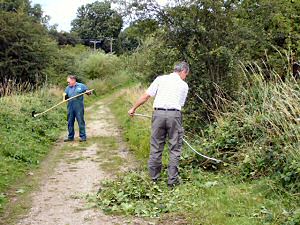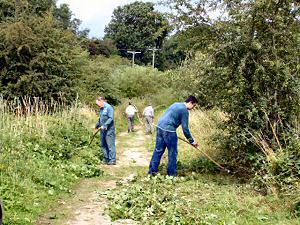Jay Smith
Some weeks ago now my Dad (Peter Smith) asked me if I fancied joining him and a bunch of other volunteers along with my brother, Aaron on a training session at the Netherfield Lagoons nature reserve in Nottinghamshire learning to use the scythe. Always looking for ways to expand my CV, I thought this would be an enjoyable way of spending a day in the open air involved in something very alien to the usual routines of life.
So, on the 22nd July, with my Grim Reaper outfit to hand I joined my Dad & my brother and headed over to the Lagoons, where we were soon joined by Raymond Lister and his partner, who were to be our tutors for the day. We proceeded in our vehicles along the lower path and parked outside the two green containers near to the River Trent.
The first task was to introduce Ray to the intended practice area for the day, so we headed up onto the bank between the Deep Pit and the Small Gravel Pit and looked down in the direction of the river onto the area of long grass below. At this point Ray began using some very worrying language, including terms such as ‘difficult going’ and ‘not for beginners’ each delivered with a general air of concern, leading Aaron and myself to wonder what exactly we’d let ourselves in for.
 The mood, however, was soon lightened by the appearance of Dave Gartside in the distance, who had just arrived at the rendezvous and set off in search of the rest of us, so we headed back to join him and await the arrival of the others. We did not have to wait long as Nigel Oram and Rob Woodward soon arrived to complete the group.
The mood, however, was soon lightened by the appearance of Dave Gartside in the distance, who had just arrived at the rendezvous and set off in search of the rest of us, so we headed back to join him and await the arrival of the others. We did not have to wait long as Nigel Oram and Rob Woodward soon arrived to complete the group.
Ray began the training with an introduction to the theory and equipment we were to employ during the day and into the future.
It seems that scything can be split into two very distinct applications, each dictates its own specific technique and equipment set-up.
‘Mowing’ is used to clear large and relatively flat areas of long or short grass and uses a long blade (around 85cm) with a very shallow profile sharpened to a very fine edge. The last millimetre or so at the edge of the blade is more like a foil and can be easily bent with the back of your thumbnail. A wide sweeping motion is employed, allowing you to clear a strip approximately 3m in width with each pass. Someone well experienced with the Scythe can clear an area 5m by 5m to a high standard in around a minute and a half using this technique.
‘Brush Cutting’ is used to clear areas of dense undergrowth and is much tougher than mowing. It employs much shorter strokes with a shorter blade (around 60cm) which has a deeper profile making it much more durable. The blade should also have what is called a ‘stone point’. A blunt tip that can impact hard objects without risking damage to the blade.
With Ray having talked about whetting, tangs, snaths, nips and beards I (and I suspect some of the others) was left somewhat bemused, and so was glad to enter a more practical phase to the day with a demonstration from Ray.
It was now that we learned the capabilities of the equipment we were to be using, which to my mind and in the context of today’s mechanised world by far exceeded what I had been expecting. Ray stepped into an area to the side of the containers and with an easy and relaxed action, swiftly cleared a sizeable area of brambles and undergrowth. ‘Combing’ down across the top of the undergrowth to make lengths of entangled bramble more manageable before under cutting the area in repetitive sweeps, inching forward and taking the undergrowth down to near ground level. It was an impressive example of what we were all about to inflict on the surrounding environment.

Emboldened by what we had just witnessed, it was now our turn and we each set off equipped with our own scythe to practice the techniques that had been the topic of the morning. It had been decided that we would work along the edges of the lower path, heading towards the car auction gates at the far end from where we were assembled. We each chose a spot and began to throw our enthusiasm at the undergrowth, each with varying levels of success.
At this point Jackie Dennison arrived and took some photos (which accompany this text) before helping by raking up after us for a while.
We carried on along the lower path until taking a hard earned break for lunch.
After lunch Ray started with some more theory. This time he discussed maintaining and sharpening the scythe, including ‘peening’ and edging the blade. Peening involves drawing out the edge of the blade using a hammer and small ‘bar peen anvil’ to achieve the desired profile before edging the blade using a whet stone. Different grades of whet stone coarseness are used to achieve the final edge.

We then continued to make as much progress as we had time to along the lower path, taking the edges back by around a meter from the edge of the track, before the group headed back to camp, leaving Aaron and I to clear the debris of the group’s endeavours.
Thus concluded a very rewarding and educational day at the lagoons.
Further reading on this subject can be found at The Scythe Shop and www.scytheconnection.com.